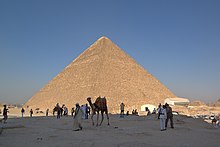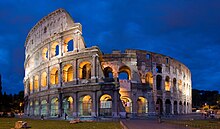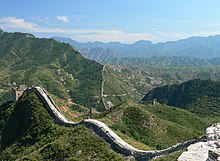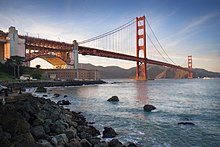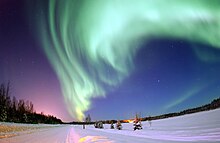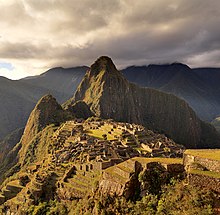American Society of Civil Engineers
The American Society of Civil Engineers compiled a list of wonders of the modern world:| Wonder | Date started | Date finished | Location |
|---|---|---|---|
| Channel Tunnel | December 1, 1987 | May 6, 1994 | Strait of Dover, between the United Kingdom and France |
| CN Tower | February 6, 1973 | June 26, 1976, tallest freestanding structure in the world 1976–2007. | Toronto, Ontario, Canada |
| Empire State Building | January 22, 1930 | May 1, 1931, Tallest structure in the world 1931–1967. First building with 100+ stories. | New York, NY, U.S. |
| Golden Gate Bridge | January 5, 1933 | May 27, 1937 | Golden Gate Strait, north of San Francisco, California, U.S. |
| Itaipu Dam | January 1970 | May 5, 1984 | Paraná River, between Brazil and Paraguay |
| Delta Works/ Zuiderzee Works | 1920 | May 10, 1997 | Netherlands |
| Panama Canal | January 1, 1880 | January 7, 1914 | Isthmus of Panama |
New7Wonders Foundation
Main article: New Seven Wonders of the World
In 2001 an initiative was started by the Swiss corporation New7Wonders Foundation to choose the New Seven Wonders of the World from a selection of 200 existing monuments. Twenty-one finalists were announced January 1, 2006. Egypt was not happy with the fact that the only original wonder would have to compete with the likes of the Statue of Liberty, the Sydney Opera House, and other landmarks; and called the project absurd. In response, Giza was named an honorary Candidate. The results were announced on July 7, 2007:| Wonder | Date of construction | Location |
|---|---|---|
| Great Wall of China | 5th century BCE – 16th century CE | China |
| Petra | c.100 BCE | Jordan |
| Christ the Redeemer | Opened 12 October 1931 | Brazil |
| Machu Picchu | c.1450 CE | Peru |
| Chichen Itza | c.600 CE | Mexico |
| Colosseum | Completed 80 CE | Italy |
| Taj Mahal | Completed c.1648 CE | India |
| Great Pyramid of Giza (Honorary Candidate) | Completed c.2560 BCE | Egypt |
USA Today's New Seven Wonders
In November 2006 the American national newspaper USA Today in conjunction with the American television show Good Morning America revealed a list of New Seven Wonders as chosen by six judges. The wonders were announced one per day over a week on Good Morning America. An eighth wonder was chosen on November 24, 2006 from viewer feedback.| Number | Wonder | Location |
|---|---|---|
| 1 | Potala Palace | Lhasa, Tibet, China |
| 2 | Old City of Jerusalem | Jerusalem[n 1] |
| 3 | Polar ice caps | Polar regions |
| 4 | Papahānaumokuākea Marine National Monument | Hawaii, United States |
| 5 | Internet | Earth |
| 6 | Maya ruins | Yucatán Peninsula, México |
| 7 | Great Migration of Serengeti and Masai Mara | Tanzania and Kenya |
| 8 | Grand Canyon (viewer-chosen eighth wonder) | Arizona, United States |
Seven Natural Wonders of the World
Similar to the other lists of wonders, there is no consensus on a list of seven natural wonders of the world, as there has been debate over how large the list should be. One of the many lists was compiled by CNN:- Grand Canyon
- Great Barrier Reef
- Harbor of Rio de Janeiro
- Mount Everest
- Aurora
- Parícutin volcano
- Victoria Falls
Seven Natural Wonders: is a not for profit endeavour created to protect the seven natural wonders that have already been established.
Seven Wonders of the Underwater World
The Seven Underwater Wonders of the World was a list drawn up by CEDAM International, an American-based non-profit group for divers, dedicated to ocean preservation and research.In 1989 CEDAM brought together a panel of marine scientists, including Dr. Eugenie Clark, to pick underwater areas which they considered to be worthy of protection. The results were announced at The National Aquarium in Washington DC by actor Lloyd Bridges, star of TV's Sea Hunt:
- Palau
- Belize Barrier Reef
- Great Barrier Reef
- Deep-Sea Vents
- Galápagos Islands
- Lake Baikal
- Northern Red Sea
Seven Wonders of the Industrial World
Main article: Seven Wonders of the Industrial World
British author Deborah Cadbury wrote Seven Wonders of the Industrial World, a book telling the stories of seven great feats of engineering of the 19th and early 20th centuries. In 2003 the BBC made a seven-part documentary series on the book, with each episode dramatising the construction of one of the wonders. The seven industrial wonders are:- SS Great Eastern
- Bell Rock Lighthouse
- Brooklyn Bridge
- London sewerage system
- First Transcontinental Railroad
- Panama Canal
- Hoover Dam
